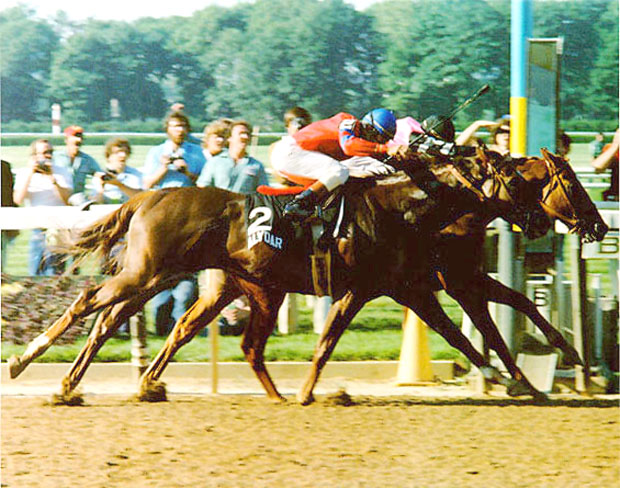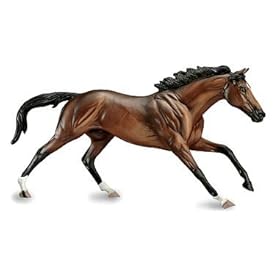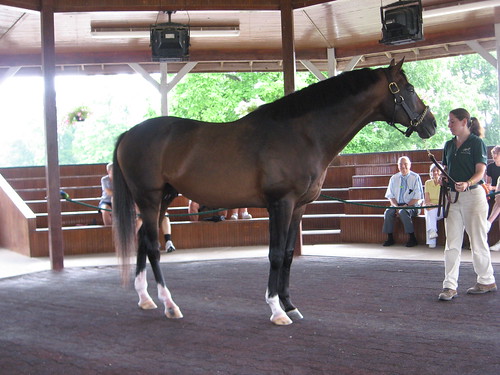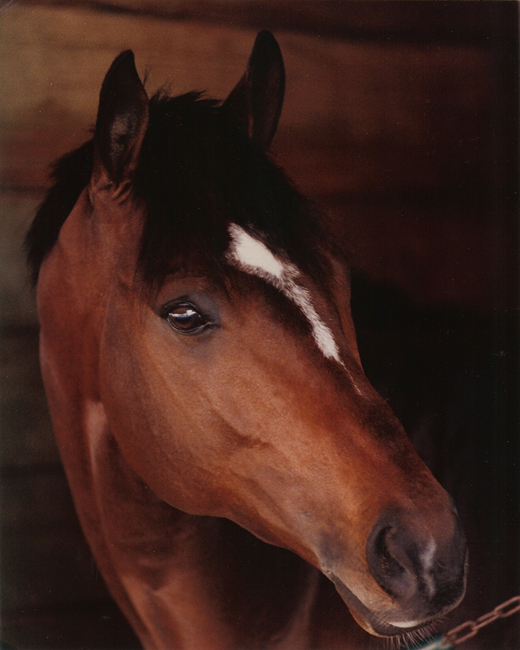Most people only manage to get their hands on one of these races during their entire career. The very talented will gain a few more wins in the Triple Crown series, some winning all three races at separate time, but only eleven teams have had the horse to win all three at once.

The Triple Crown consists of three races, The Kentucky Derby, Preakness Stakes, and Belmont Stakes, for horses of either gender, so long as they are only three years old. Alone, these races are like any other, but combined they present a challenge for even the best of horses.
The races cover three different distances over three different tracks. By today's standards the Triple Crown races are also much closer together than most modern race horses can handle.
The
Kentucky Derby is the first and probably most famous of the Triple Crown races. It is held at Churchill Downs in Louisville, Kentucky on the first Saturday of May. No matter the horses in the race, the Derby always pulls in the biggest crowd and the biggest field of horses. On the way to the gates, the crowd sings 'My Old Kentucky Home' to welcome to three year-olds to the track. This race is run on the dirt over one and a quarter miles or ten furlongs. At the end of the race the winner gets to stand in the special Derby winner circle and receive the coveted blanket of roses.
The
Preakness Stakes is next on the card, being run at Pimlico Race Course in Baltimore, Maryland. With the singing of 'Maryland My Maryland' the horses are guided to the gates for the second leg of the Triple Crown. As the gates open, they take a trip around a dirt track for one and three sixteenths miles or nine furlongs making it the shortest of the three races. With a win here the horse is draped with the next set of flowers, black-eyed Susans.
The third and final leg of the Triple Crown is
Belmont Stakes, at Belmont Park Elmont, New York. Depending on the outcome of the first two races the second Saturday in June could be the most exciting race. If a horse has one both the Derby and the Preakness, all that is needed is a win in the Belmont for a new Triple Crown winner. With this hope 'Sidewalks of New York' (the theme from
New York New York) rings through the stands while the horses prepare to run for the win. The race will take the horses a mile and half or twelve furlongs on dirt. No matter if it is an upset or a historical event, the winning horse is adorned with the last blanket of Belmont flowers: white carnations.
Plenty of horses have run these prestigious races, but only eleven have ever won the Triple Crown. For this reason, these horses will always be legends. Although all these winners are amazing athletes, two horses in particular stand out in my mind for impressive wins.

The horse that had the most magnificent Triple Crown run was Secretariat. He was a super horse. He won the Derby while setting a record that still stands and has only been challenged once, in the Preakness he won effortlessly, and his win in the Belmont was the most amazing feat that track has ever seen. Secretariat won by thirty-one horse lengths. He was so far ahead his jockey actually turned to look over his shoulder to see just how far back the competition was.

On the complete opposite side of the spectrum was the Triple Crown's best rivalry:
Alydar vs.
Affirmed. Every time these two horses met it ended in an intense stretch battle, and the Triple Crown was no exception. The two ran their hardest for each race, and each time Affirmed came out the winner. Due to their bitter rivalry Alydar also had a Triple Crown first. He was the first and only horse to be second in all three races. Although this is not quite as impressive as being first, it still shows how amazing he and Affirmed were.
Although these were some fantastic wins, most horses aren't lucky enough to win all three.
To the public, the most disappointing loss is when a horse wins the Derby and the Preakness but falls short in the Belmont. Since the year 2000 four horses (War Emblem '02, Funny Cide '03, Smart Jones '04, and Big Brown '08) have done just that. They get America excited for a potential Triple Crown, only to crash the bandwagon. There are many reasons for losing the Belmont after winning the first two legs.
The most popular reason to blame the loss on is the fact that modern race horses simply don't run as often as the Triple Crown schedule demands. Other reasons for losing this big race is that it is the longest, new and rested challengers, as well as uncontrollable things such as track condition (muddy from rain), or even the horses mood. Big Brown for example, won the first two races easily but failed miserably in the Belmont. There was a lot of fuss about a loose shoe, but I think his head just wasn't in it. He wasn't bucking in his stall that morning like normal and he just looked unfocused on the track. But no matter the reason, horses tend to lose the Belmont.
Although it is very disappointing when a Triple Crown contender loses at the last moment, I am more agitated when the horse loses the Kentucky Derby, but goes on to win Preakness and the Belmont. Luckily for me, this has only happened twice since 2000 with Point Given '01 and Afleet Alex '05. The reason I find this so irritating is simply because when the run in all three races but win the last two that means they have stamina to run and to win the Triple Crown.
There are just as many reasons to fail at the Derby as it there is for the Belmont. For some horses this is the first time they have gone around two turns, others are afraid of the crowds. Not only are the stands stuffed, but the inside of the track is packed as well. Some horses can handle this, but others can't and get nervous. If this wasn't enough to deal with all the people, dealing with all the horses can unnerve even the most seasoned horse.
The Derby is open for the twenty top three year-olds in the nation, and all those slots are filled come race day. On the average, there are usually eight horses in American races, so twelve more horses is beyond frightening for these youngsters. Even if the horse doesn't fear the big crowd, that many horses makes it hard to have a good trip. There is more bumping with this many horses which can destroy focus or even injure a horse. Despite that, sometimes the opening the horse needs just never appears making it almost impossible to get past the field.
With all these factors the Triple Crown truly is the most exciting event in horse racing. If you can only watch three races a year, make them the Kentucky Derby, Preakness Stakes, and Belmont Stakes. Even if you don't see a Triple Crown sweep, you will surely see some amazing races and some amazing three year-olds.
It has been thirty years since America's last Triple Crown win; will this be the year to break that streak?

 Another breed of horse that races is the Standardbred. These horses race in an entirely different manor than their cousins the Quarter Horse or Thoroughbred. They are harness racers and race with sulkies which are light weight racing carts.
Another breed of horse that races is the Standardbred. These horses race in an entirely different manor than their cousins the Quarter Horse or Thoroughbred. They are harness racers and race with sulkies which are light weight racing carts.


 The Triple Crown consists of three races, The Kentucky Derby, Preakness Stakes, and Belmont Stakes, for horses of either gender, so long as they are only three years old. Alone, these races are like any other, but combined they present a challenge for even the best of horses.
The Triple Crown consists of three races, The Kentucky Derby, Preakness Stakes, and Belmont Stakes, for horses of either gender, so long as they are only three years old. Alone, these races are like any other, but combined they present a challenge for even the best of horses.



 This next picture is both amazing and kind of funny. The horse is caught mid jump, giving the allusion of flying. The horse was jumping shadows on the track surface.
This next picture is both amazing and kind of funny. The horse is caught mid jump, giving the allusion of flying. The horse was jumping shadows on the track surface. 


 This model seems like any other
This model seems like any other 









